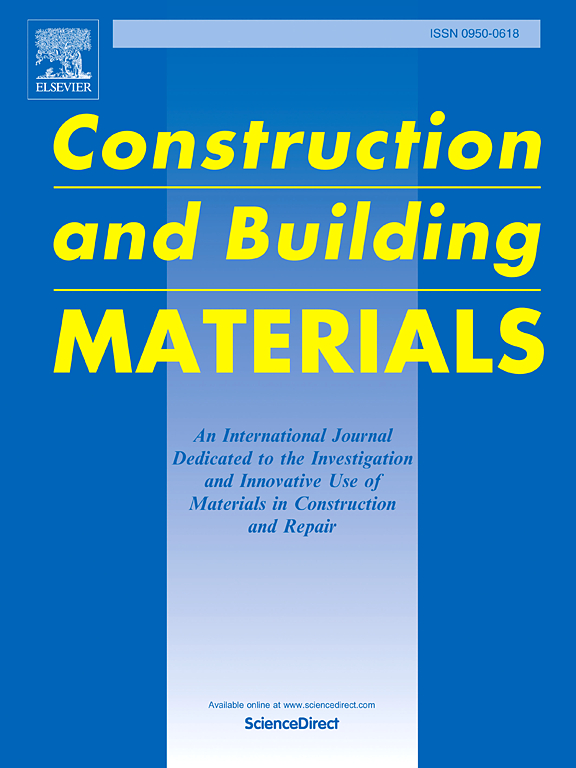不同界面剂对UHPC-NC粘结性能的多尺度表征
IF 7.4
1区 工程技术
Q1 CONSTRUCTION & BUILDING TECHNOLOGY
引用次数: 0
摘要
双材料结构的界面结合性能受到多种因素的影响,包括表面粗糙度、界面剂的存在、表面含水量等,它们是决定结构整体性能和耐久性的关键因素。不同材料之间的界面表现出非均质性和不连续性。本研究采用环氧树脂、纳米环氧树脂、高强砂浆和纤维增强砂浆四种界面剂,研究界面非均质性和连续性对混合再生轮胎钢纤维增强混凝土或超高性能混凝土(UHPC)与普通强度混凝土(NC)粘结性能的多尺度效应和粘结机理。多尺度分析包括宏观(即表面形貌、拉伸结合强度和剪切结合强度)、介观(即纤维分布、界面过渡区大小和孔隙结构)和微观(即微观形貌和水化产物特性)表征。研究结果表明,改善界面的非均匀性和连续性可以提高UHPC-NC界面的粘结性能。与未添加界面剂的对照组相比,在UHPC-NC层间添加成分和性能相似的化学界面剂时,试样的拉伸和剪切强度分别比对照组高71.46 %和15 %。本研究表明,界面结合性能的提高是由于水化产物的形成和界面过渡区的致密化,受化学结合、纤维增强和物理吸附作用的支配。建立了界面过渡区尺寸与界面结合强度之间的关系。基于应力波传播理论,阐述了界面非均质性和连续性对UHPC-NC复合材料破坏模式和粘结性能的影响机理。结果表明,改变UHPC-NC层之间的界面连续性是控制界面结合强度及其破坏模式的关键。本文章由计算机程序翻译,如有差异,请以英文原文为准。
Multiscale characterization of bond performance of UHPC-NC with different interface agents
The interface bonding properties of bi-material structures are influenced by a variety of factors, including surface roughness, presence of interface agents, moisture content of surface, etc., and they are critical factors in determining the overall performance and durability of structures. Interface between dissimilar materials exhibits heterogeneity and discontinuity. In this study, four types of interface agents (i.e., epoxy resin, nano-epoxy resin, high-strength mortar, and fiber-reinforced mortar) are proposed to investigate the multiscale effect and bonding mechanism of interface heterogeneity and continuity on the bond performance between hybrid recycled tire steel fiber reinforced concrete or ultra high performance concrete (UHPC) and normal strength concrete (NC). The multiscale analyses include the macroscopic (i.e., surface morphology, tensile bond strength, and shear bond strength), mesoscopic (i.e., fiber distribution, size of interface transition zone, and pore structure), and microscopic (i.e., micro-morphology and hydration product characteristics) characterization. The findings indicate that improving the interface heterogeneity and continuity enhances the bond performance of UHPC-NC interface. Compared with the reference group without the interface agent, the samples reach the highest tensile and shear bond strength, which are 71.46 % and 150 % higher than those of the reference ones, respectively, when the chemical interface agent with similar components and properties between the UHPC-NC layers is deployed. The present study reveals that the improvement in interface bond performance is attributed to the formation of hydration products and the densification of interface transition zone, governed by the chemical bonding, fiber reinforcement, and physical adsorption effects. Furthermore, the relationship between the size of interface transition zone and interface bond strength is established. Based on the theory of stress wave propagation, the influencing mechanism of interface heterogeneity and continuity on the failure mode and bond performance of UHPC-NC composites is elucidated. It concludes that altering the interface continuity between the UHPC-NC layers is the key to control the interface bond strength and its failure modes.
求助全文
通过发布文献求助,成功后即可免费获取论文全文。
去求助
来源期刊

Construction and Building Materials
工程技术-材料科学:综合
CiteScore
13.80
自引率
21.60%
发文量
3632
审稿时长
82 days
期刊介绍:
Construction and Building Materials offers an international platform for sharing innovative and original research and development in the realm of construction and building materials, along with their practical applications in new projects and repair practices. The journal publishes a diverse array of pioneering research and application papers, detailing laboratory investigations and, to a limited extent, numerical analyses or reports on full-scale projects. Multi-part papers are discouraged.
Additionally, Construction and Building Materials features comprehensive case studies and insightful review articles that contribute to new insights in the field. Our focus is on papers related to construction materials, excluding those on structural engineering, geotechnics, and unbound highway layers. Covered materials and technologies encompass cement, concrete reinforcement, bricks and mortars, additives, corrosion technology, ceramics, timber, steel, polymers, glass fibers, recycled materials, bamboo, rammed earth, non-conventional building materials, bituminous materials, and applications in railway materials.
 求助内容:
求助内容: 应助结果提醒方式:
应助结果提醒方式:


